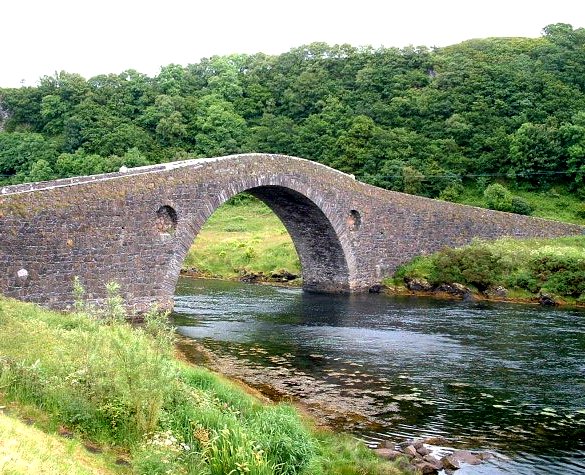Clachan Bridge on:
[Wikipedia]
[Google]
[Amazon]

 The Clachan Bridge is a simple, single-arched, hump-backed,
The Clachan Bridge is a simple, single-arched, hump-backed,

 The Clachan Bridge is a simple, single-arched, hump-backed,
The Clachan Bridge is a simple, single-arched, hump-backed, masonry
Masonry is the building of structures from individual units, which are often laid in and bound together by mortar; the term ''masonry'' can also refer to the units themselves. The common materials of masonry construction are bricks, building ...
bridge spanning the Clachan Sound, southwest of Oban in Argyll
Argyll (; archaically Argyle, in modern Gaelic, ), sometimes called Argyllshire, is a historic county and registration county of western Scotland.
Argyll is of ancient origin, and corresponds to most of the part of the ancient kingdom of ...
, Scotland. It links the west coast of the Scottish mainland to the island
An island (or isle) is an isolated piece of habitat that is surrounded by a dramatically different habitat, such as water. Very small islands such as emergent land features on atolls can be called islets, skerries, cays or keys. An island ...
of Seil
Seil (; gd, Saoil, ) is one of the Slate Islands, located on the east side of the Firth of Lorn, southwest of Oban, in Scotland. Seil has been linked to the mainland by bridge since the late 18th century.
The origins of the island's name are ...
.
The bridge was originally designed by John Stevenson of Oban (and not by Thomas Telford
Thomas Telford FRS, FRSE, (9 August 1757 – 2 September 1834) was a Scottish civil engineer. After establishing himself as an engineer of road and canal projects in Shropshire, he designed numerous infrastructure projects in his native Scot ...
as sometimes quoted) and was built between 1792 and 1793 by engineer
Engineers, as practitioners of engineering, are professionals who invent, design, analyze, build and test machines, complex systems, structures, gadgets and materials to fulfill functional objectives and requirements while considering the limit ...
Robert Mylne. The original design had two arches, but it was finally built with a single high arch, of roughly span and about above the bed of the channel, to allow the passage of vessels of up to at high tide. The bridge is still in use today, forming part of the B844 road, and is in the care of Historic Scotland
Historic Scotland ( gd, Alba Aosmhor) was an executive agency of the Scottish Office and later the Scottish Government from 1991 to 2015, responsible for safeguarding Scotland's built heritage, and promoting its understanding and enjoyment ...
.
Because the Clachan Sound connects at both ends to the Atlantic Ocean
The Atlantic Ocean is the second-largest of the world's five oceans, with an area of about . It covers approximately 20% of Earth's surface and about 29% of its water surface area. It is known to separate the " Old World" of Africa, Europe ...
, and might therefore be considered part of that ocean, the bridge came to be known as the Bridge over the Atlantic ( gd, a' Dhrochaid thar a' Chuain Siar). Such an appellation has also been applied to certain other bridges having similar situations, such as the Brúgvin um Streymin in the Faroe Islands
The Faroe Islands ( ), or simply the Faroes ( fo, Føroyar ; da, Færøerne ), are a North Atlantic island group and an autonomous territory of the Kingdom of Denmark.
They are located north-northwest of Scotland, and about halfway bet ...
and between Lewis
Lewis may refer to:
Names
* Lewis (given name), including a list of people with the given name
* Lewis (surname), including a list of people with the surname
Music
* Lewis (musician), Canadian singer
* "Lewis (Mistreated)", a song by Radiohead ...
and Great Bernera
Great Bernera (; gd, Beàrnaraigh Mòr), often known just as Bernera ( gd, Beàrnaraigh), is an island and community in the Outer Hebrides of Scotland. With an area of just over , it is the thirty-fourth largest Scottish island.
Great Bernera l ...
in the Outer Hebrides.
Wildlife
The south wall of the bridge has been colonised by fairy foxglove (''Erinus alpinus''). Occasionally whales have become trapped in the narrow Clachan Sound. In 1835 a whale measuring with a lower jaw of was stranded having become trapped in shallow water and unable to reverse out. In 1837, 192 pilot whales were caught in a similar fashion, the largest being long.References
{{coord, 56, 19, 04, N, 5, 34, 59, W, display=title, region:GB-AGB_type:landmark_source:dewiki Seil Bridges completed in 1793 Category A listed buildings in Argyll and Bute Listed bridges in Scotland Road bridges in Scotland Bridges in Argyll and Bute 1793 establishments in Great Britain